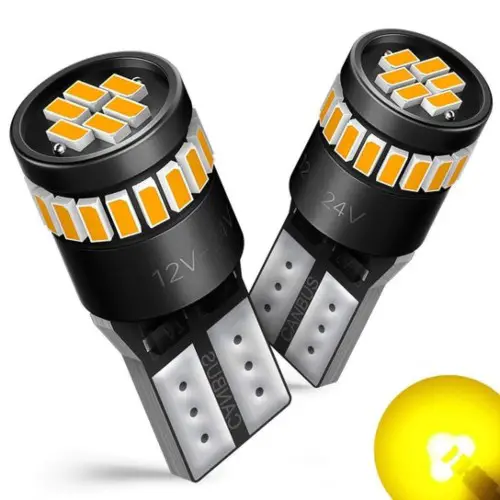gmund-20
Need tools for your project? Toolbox, a tool rental marketplace, might be worth a look.

What is a 168 bulb?
A 168 bulb is a compact automotive lamp designed for the car’s interior or side marker lights. Its LED variant can also be used for park and signal lights since it is significantly brighter than its incandescent and halogen counterparts.
This bulb type emits 38 lumens as a stock light. It has a candlepower rating of 3, and it draws 0.35 amperes to operate. For this reason, it is a good choice for auxiliary safety lights to give other drivers a good view of the vehicle without producing any glare. As such, you can install it near your vehicle’s rear quarter panel, bumper, or fender.
A 168 bulb works at 14 volts, and it pulls 4.9 watts of energy which makes it a bright bulb. Nonetheless, its slightly high wattage makes it throw out more heat. As such, it is not ideal for some applications substitutions.
Since it heats up, the lifespan is only 1,500 hours.
This bulb is 1.06 inches in diameter and features a C-2F filament. It has a single coil filament design, so it’s only for one circuit. The bulb also has a tungsten filament construction because of its high melting point at incandescence.
What is a 194 bulb?

A 194 bulb is also a miniature automotive lamp. This bulb is designed for interior and instruments lights since it does not emit heat. For this reason, it is also not a very bright light. In addition, a 194 bulb has a candlepower rating of 2 and 24 lumens as a stock light.
Since it is not very bright, it is ideal for indicator lights only. Therefore, it is not suitable for turn signals or brake lights. Its best uses are the footwell lights, dashboard lights, radio dial lights, ignition lights, clock lights, and more.
A 194 bulb operates at an applied voltage of 14 volts and has 3.5 watts energy rating. It will draw 0.27 amperes to run. As such, it does not get hot; that’s why it can last up to 2,500 hours. This bulb comes with a glass-wedge base featuring a C-2F filament design.
As for the size, a 194 bulb is also 1.06 inches in diameter and features a T3 bulb shape. It can fit even the smallest spaces in your vehicle.
168 and 194 bulbs: What are the similarities?
It’s not uncommon for people to confuse 168 and 194 bulbs because they have many similarities, as I’ll discuss in this section.
Size and shape
Both 168 and 194 bulbs are 1.06 inches in diameter and feature a T3 design. The tubular shape allows them to function in various applications. Also, these bulbs can fit into tight spaces thanks to their small size.
168 and 194 bulbs also share the same base size, so they are direct replacements for each other in any stock housing connector.
Voltage
As I mentioned, you will find that both bulbs operate at 14 volts. These are cooler burning bulbs and use less energy than other bulb types used for the same purposes. However, they are not as bright as other bulbs because of the low voltage and often have a lower color temperature.
Bulb type
You will find 168 and 194 bulbs in the fundamental types, including halogen, incandescent, and LED. The LED options for these bulbs allow you to choose different color temperatures. However, LEDs are more expensive than halogen and incandescent bulbs.
The differences between 168 vs. 194 bulbs
After comparing 168 and 194 bulbs, I found several differences between them. If you’re debating which of the two is suitable for your needs, understanding their differences will help you decide.
Quick comparison table

Brightness
168 bulbs are brighter than 194 bulbs since they have a candlepower rating of 3 compared to a candlepower of 2 in 194 bulbs. Even if the brightness seems minor, you will notice this thing immediately after installing the bulbs. In addition, 168 bulbs offer comprehensive coverage; that’s why they are better for cabin lights.
The brightness level is also another significant difference between the two bulbs. To this end, 168 bulbs have different brightness levels, while 194 bulbs only have one brightness setting. Therefore, you can use a 168 bulb on your dashboard or gauge cluster where you can dim or brighten it according to the ambient conditions.
Wattage
These bulbs have a subtle difference in their wattage. 168 bulbs use 4.9 watts of energy, while 194 bulbs consume only 3.8 watts. Nevertheless, this feature makes the 168 a brighter bulb since you will have more light than a 194 lamp. That’s why 168 bulbs offer better interior coverage.
Heat performance
A common complaint among drivers is that 168 bulbs emit more heat than 194 lamps. In some cases, 168 bulbs may melt plastic parts or cause discomfort for the driver. For this reason, 168 bulbs are not meant to be on at all times.
Again, heat could be a problem if you use a 168 bulb in the instrument cluster because of the plastic parts. It may also be a problem if you experience eyestrain with a very bright bulb.
Application
The best uses for a 168 bulb are in the interior cabin lights, warning lights, glove compartment, map lights, etc. As I’ve mentioned, it should be on less often because of its high heat output.
194 bulbs are suitable in places where you need continuous lighting. Therefore, they are better for indicator and instrument lights and in cases where you cannot use the less bright 161 bulbs.
Lifespan
168 bulbs have a rated service life of 1,500 hours with moderate use. However, 194 bulbs have an outstanding lifespan of 2,500 hours. It’s one of the reasons why drivers prefer 194 bulbs over 168 bulbs.
Remember that longevity depends on the type of bulb and usage. If your 194 light is used heavily, its lifespan can reduce significantly.
Price
Although 194 bulbs are not as bright as 168 bulbs, they are slightly pricey. I found that 194 bulbs’ price tag is above $10 for a pack of ten while 168 bulbs are often below $10. It shows that most drivers are willing to compromise on brightness to have a long-lasting bulb.
Best 168/194 bulbs
1. SIRIUS LED 194 bulbs extremely super bright
SIRIUS LED bulbs are best-known for their reliable performance. This pack of ten 194 bulbs offers OEM-style functionality. These are non-CANBUS bulbs, so no worries if your vehicle is not CANBUS compatible. Nevertheless, these bulbs give you enhanced functionality and flicker-free performance.
Each bulb uses a 3030 high-power SMD chip, offering low energy consumption and long life. These bulbs have a cool white color temperature, making them ideal for dome lights, license plate lights, door lights, map lights, or trunk lights.
I find the plug-and-play installation super easy since the bulbs are non-polar-specific. In addition, you can use a 168-bulb socket with no worries.
Pros
- Vibrant cool white color
- Flicker-free performance
- Increased output from LED chip
- Fits multiple applications
Cons
- Some drivers don’t like the blue tint in them
- The printed circuit base looks more fragile than a plastic base

SIRIUSLED 194 LED Bulbs
2. JDM ASTAR 10Pcs super bright 194/168
JDM ASTAR offers these white LEDs in a pack of ten. You’ll be able to have uniform lighting in all areas where these bulbs apply in your car. These bulbs offer better performance than stock lights since they emit a bright white light, rated at 6000K.
I like that they have a wedge that will fit 194 and 168 bulb sockets. They will also go into 147, 152, 158, 159, 161, 175, 184, 192, 193, 2825, 2827, and W5W sockets. You’ll like that they just plug into the housing without tools. In addition, they are non-CANBUS, so they won’t show an error in your electric control system.
With the help of authentic PX chips, the bulbs enjoy a long lifespan even with heavy use.
Pros
- 120 lumens light output per bulb
- Do not flicker
- Compatible with many applications
- Bright white color
- Dim to turn off when the door is closed
Cons
- Complicated to install in the trunk socket on some vehicles

JDM ASTAR 10pcs Super Bright
3. iBrighstar newest extremely bright wedge 168/194 LED bulbs
If you’re looking for the longest-lasting bulbs that are still super bright, you will like the iBrightstar LED bulbs. Each bulb boasts three pieces of 3030 SMD chips, and hence, they are very efficient such that they can last for an overwhelming 50,000 hours.
Another thing I like is that they can fit different positions in and outside your car. You can use them as dome lights, courtesy lights, parking lights, interior map lights, cargo lights, and many others. They have a non-polarity design, so you only need to plug them in their socket.
iBrightstar uses an aluminum-grade housing and a heatsink to prevent overheating. As such, they can withstand road vibrations, and they will not become loose over time.
Pros
- 500% brighter than halogen bulbs
- Daylight white (5600K) color
- Dimmable and flicker-free
- Interchangeable in 168 and 194 sockets
- Available in different colors
Cons
- Connector issues on the dome and map light on the 2012 Mercedes C250
- Appear dim when connected to 9V circuit

iBrighstar newest extremely bright
4. AUXITO 194 LED light bulb 6000K white
AUXITO is one of the best brands for interior lighting. These LED bulbs are CANBUS error-free, so they don’t need a decoder in 95% of vehicles. The bulbs come in a pack of ten. However, six of these bulbs are ideal for map lights, glove box lights, trunk lights, and door lights, while the other four are for use as parking lights and license plate lights.
The best feature of these bulbs is that they have 24 3014 LED chips to offer 360 degrees lighting. Hence you can avoid blind spots when parking. The LED chips extend the lifespan of these bulbs to 40,000 hours. Thus, you get extraordinary quality, unlike what you experience with subpar LED bulbs.
Pros
- Universal 168/194 connector
- Built-in intelligent IC driver
- 360 degrees viewing angle
- Low power consumption
- Wide application
Cons
- Can burn out due to heat when installed as front parking lights

AUXITO 194 LED light bulb 6000K white
Read more: 5000K Vs. 6000K Vs. 8000K: Which bulb suits you best?
5. SYLVANIA 168.TP 168 Basic Miniature Bulb
SYLVANIA 168 LED bulbs offer a balanced combination of value and performance. Whether you want parking lights, license plate lights, or are looking for reading and dome lights, these bulbs fit perfectly. With these LEDs, you can easily replace your incandescent bulbs for a unique and modern look.
Each bulb emits a white color ideal for interior and exterior lighting. The OEM size and shape allows the bulbs to snap into their socket in any direction. Additionally, they use high-quality SMD LED chips that reduce energy consumption. Thus, you don’t risk a dead battery if you leave them on.
Pros
- CANBUS error-free
- Withstands road shock and vibration
- Multipurpose use
- Low energy consumption
- 360 degrees illumination
Cons
- Dim over time
- Require replacement in pairs

SYLVANIA 168 LED bulbs
Conclusion
It’s a close call between 168 vs. 194 bulbs, but I hope I’ve defined their attributes to help you distinguish them. Now, you can decide which of the two types is suitable for your car. Remember that 168 bulbs are brighter than 194 bulbs, but they emit more heat and don’t last as long as 194 bulbs.
All in all, I trust that you can make a choice that suits you best.
Read more: 3457 vs. 3157: Which bulb should i use?


